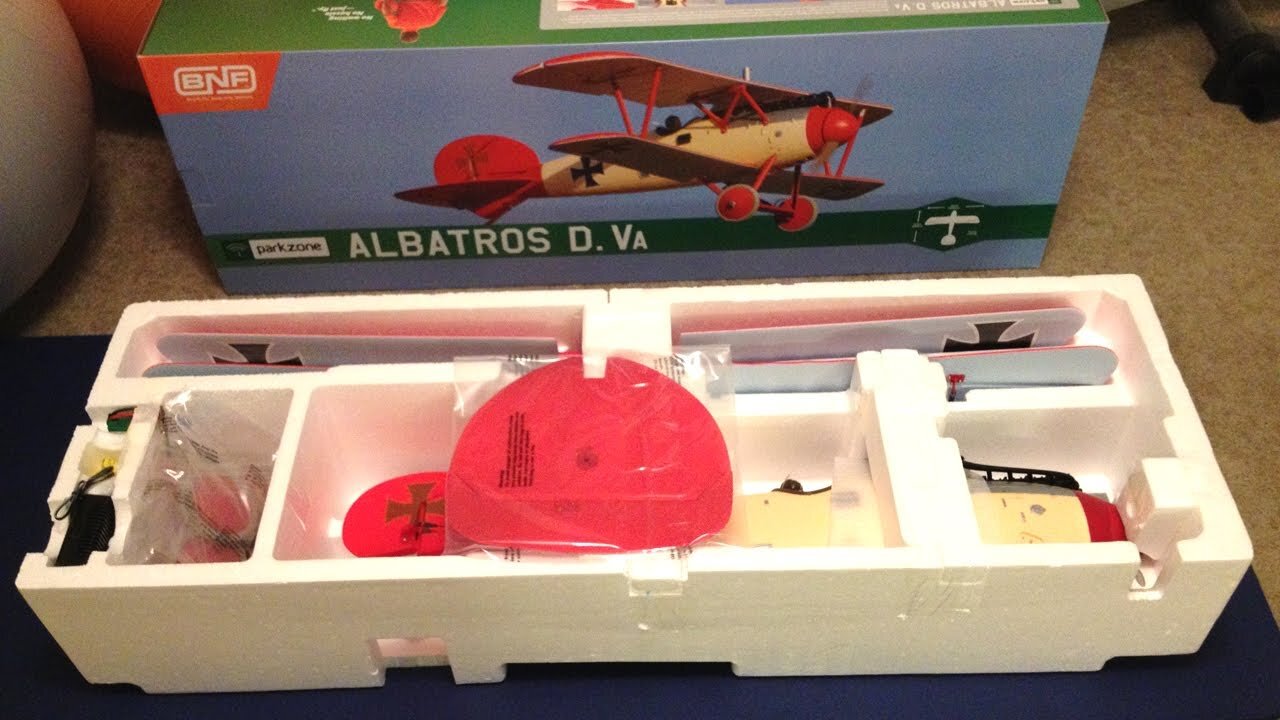Premium Only Content

Parkzone Albatros D.Va WWI Warbird BNF Airplane Review and Maiden Flight
This video contains the Parkzone Albatros D.Va WWI Warbird review and maiden flight. This is the plane that the Red Baron made famous in World War One. Or said another way, this is the Red Baron Plane the is probably the most widely recognized warbird aircraft from WWI.
This review includes a complete unboxing of the plane and I discuss its parts and pieces as the review progresses.
I almost bought the Parkzone S.E.5a instead of the the Albatros. After reading all of the reviews, I decided that the PZ Albatros was the way to go and if I liked that, The SE5a was going to be my next plane purchase since I enjoy the look of a WW1 airplane.
I flew this plane with my trusty Spektrum DX6i and it worked very well. The flight resulting in a nice smooth landing and a big deep sigh of relief from me.
Historical background (via Wikipedia):
The Albatros D.V was a fighter aircraft used by the Luftstreitkräfte (Imperial German Air Service) during World War I. The D.V was the final development of the Albatros D.I family, and the last Albatros fighter to see operational service. Despite its well-known shortcomings and general obsolescence, approximately 900 D.V and 1,612 D.Va aircraft were built before production halted in early 1918. The D.Va continued in operational service until the end of the war.
In April 1917, Albatros received an order from the Idflieg (Inspektion der Fliegertruppen) for an improved version of the D.III. The resulting D.V prototype flew later that month.
The D.V closely resembled the D.III and used the same 127 kW (170 hp) Mercedes D.IIIa engine. The most notable difference was a new fuselage which was 32 kg (70 lb) lighter than that of the D.III.[1] The elliptical cross-section required an additional longeron on each side of the fuselage. The vertical fin and tailplane remained unchanged from the D.III.[1] The prototype D.V retained the standard rudder of the Johannisthal-built D.III, but production examples used the enlarged rudder featured on D.IIIs built by Ostdeutsche Albatros Werke (OAW).[2] The D.V also featured a larger spinner and ventral fin.
The D.V entered service in May 1917 and, like the D.III before it, immediately began experiencing structural failures of the lower wing.[4] Indeed, anecdotal evidence suggests that the D.V was even more prone to wing failures than the D.III. The outboard sections of the upper wing also suffered failures, requiring additional wire bracing.[4] Furthermore, the D.V offered very little improvement in performance.[3] This caused considerable dismay among frontline pilots, many of whom preferred the older D.III. Manfred von Richthofen was particularly critical of the new aircraft. In a July 1917 letter, he described the D.V as "so obsolete and so ridiculously inferior to the English that one can't do anything with this aircraft." British tests of a captured D.V revealed that the aircraft was slow to maneuver, heavy on the controls, and tiring to fly.[5]
Albatros responded with the D.Va, which featured stronger wing spars, heavier wing ribs, and a reinforced fuselage.[6] These modifications made the D.Va 23 kg (50 lb) heavier than the D.III, while failing to entirely cure the structural problems of the type. Use of the high-compression 130 kW (180 hp) Mercedes D.IIIaü engine offset the increased weight of the D.Va.[7] The D.Va also reverted to the D.III's aileron cable linkage, running outwards through the lower wing, then upwards to the ailerons, to provide a more positive control response.[3] The wings of the D.III and D.Va were in fact interchangeable.[3] The D.Va was also fitted with a small diagonal brace connecting the lower section of the forward interplane strut to the leading edge of the lower wing. This brace was retrofitted to some D.V aircraft.[7]
Idflieg placed orders for 262 D.Va aircraft in August 1917, followed by additional orders for 250 in September and 550 in October.[6] Ostdeutsche Albatros Werke, which had been engaged in production of the D.III, received orders for 600 D.Va aircraft in October.[6]
Deliveries of the D.Va commenced in October 1917.[6] The structural problems of the Fokker Dr.I and the mediocre performance of the Pfalz D.III left the Luftstreitkräfte with no viable alternative to the D.Va until the Fokker D.VII entered service in the summer of 1918. Production ceased in April 1918.[8] As of May 1918, 131 D.V and 928 D.Va aircraft were in service on the Western Front. This number declined as the Albatros Warbird was replaced by Fokker D.VIIs and other types during the final months of the war, but the D.Va remained in use until the Armistice (11 November 1918).
-
 3:28
3:28
GBLynden's RC
1 year ago4S Maiden | Arrows RC BAe Hawk 50mm EDF Jet
265 -
 27:39
27:39
Crypto.com
39 minutes ago2025 Live AMA with Kris Marszalek, Co-Founder & CEO of Crypto.com
-
 LIVE
LIVE
Law&Crime
1 hour agoLIVE: Adelson Matriarch Murder Trial — FL v. Donna Adelson — Day 3
222 watching -
 LIVE
LIVE
JuicyJohns
1 hour ago $0.23 earned🟢#1 REBIRTH PLAYER 10.2+ KD🟢
119 watching -
 LIVE
LIVE
Surviving The Survivor: #BestGuests in True Crime
1 hour agoCourt Stream: Donna Adelson Trial DAY 3 of Testimony
67 watching -
 LIVE
LIVE
Wendy Bell Radio
5 hours agoWhat Hill Will Democrats Choose To Die On?
8,032 watching -
 LIVE
LIVE
LFA TV
3 hours agoLFA TV ALL DAY STREAM - TUESDAY 8/26/25
5,661 watching -
 1:15:15
1:15:15
JULIE GREEN MINISTRIES
3 hours agoTHE CIA HAS BEEN A GIANT IN THIS LAND THAT WILL BE TAKEN OUT
67.7K116 -
 3:58:26
3:58:26
The Bubba Army
1 day agoBURN The FLAG, Go to JAIL! - Bubba the Love Sponge® Show | 8/26/25
54.5K19 -
 29:45
29:45
DeVory Darkins
17 hours ago $7.39 earnedDemocrat Governor suffers EMBARRASSING LOSS to Trump as ICE takes Garcia into custody
27.1K74